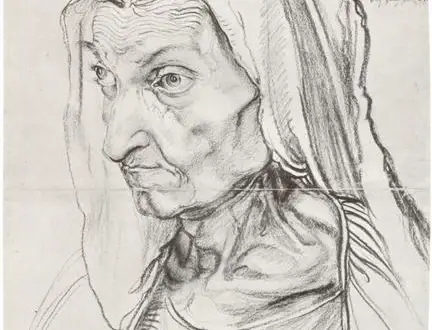Title of Artwork: “Portrait of the Artist’s Mother”

Artwork by Albrecht Durer
Year Created 1514
Summary of Portrait of the Artist’s Mother
Charcoal drawing from March 1514 by German printer and painter Albrecht Dürer, presently held in the Kupferstichkabinett, Berlin, depicts Dürer’s mother at 63 years old. Barbara Holper (c. 1451–1514), his mother, was the subject of this sympathetic yet unflinching portrait, which was completed just two months before her death.
All About Portrait of the Artist’s Mother
Dürer had a close relationship with his mother, and following her death, he wrote that she had “died hard” and that “I felt so grieved for her that I cannot explain it.” Melencolia I and Madonna by the Wall, two of his most famous 1514 engravings, have been likened to this sketch in terms of its gloomy mood.
A 1490 oil on wood panel picture presently in Nuremberg is widely believed to be either an original or a copy of a long-since-lost original. This is her second portrait. From a Paris auction house in 1877, the Kupferstichkabinett acquired around 35 Dürer drawings from the Firmin-Didot auction company.
Barbara Holper was the daughter of Hieronymus Holper, the goldsmith who trained Dürer’s Hungarian father. During his apprenticeship, Albrecht Dürer most likely stayed in the Holper home and witnessed the growth of his master’s daughter. Dürer’s father, Hieronymus Holper, was 40 years old when he married his 15-year-old daughter.
They appeared to be a good fit on the surface, but their son claims that they had a rough life together, full of disappointments and heartaches. Only two of their 18 children, born between 1468 and 1492, lived to adulthood. Jane Hutchinson, Dürer’s biographer, believes Barbara Holper may have been a goldsmith.
In the wake of his mother’s death, her son wrote “These 18 children were brought up by my holy mother, who was afflicted with a variety of terrible illnesses, was ridiculed and mocked, was subjected to countless terrors, and endured an incredible amount of hardships and hardships throughout her life.
Even so, she had no ill will. She was terrified of dying, but she stated she was not afraid to stand before God. It was clear that she had seen something horrifying, because she begged for the holy water after a long period of silence. Her eyes fell shut immediately.
I also witnessed Death’s two big strokes to the heart, and how she closed her mouth and eyes and departed with a scream of agony. The prayers were recited to her by me. I couldn’t even begin to describe how much I was hurting for her. She needs God’s mercy.”
At first glance, Dürer’s depiction of his mother’s final days may appear cruel or bizarre if he hadn’t left behind a written record of his affection for her. This woman’s face is skeleton, her skin is aged and dark, her eyes are practically disconnected, and she appears to be looking upwards toward an empty nothingness of hopelessness.
His written records on both his parents, on the other hand, are empathetic portraits of the ravages of ageing and illness on human flesh, and it is widely believed that they are sensitive analyses of these phenomena.
It was only in 1500 that Dürer created his final full-length self-portrait after meticulously documenting other people’s deteriorating physical appearances.
Information Citations
En.wikipedia.org, https://en.wikipedia.org/.






















